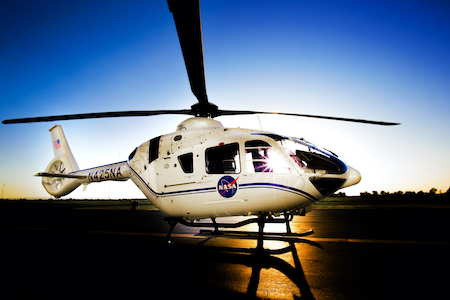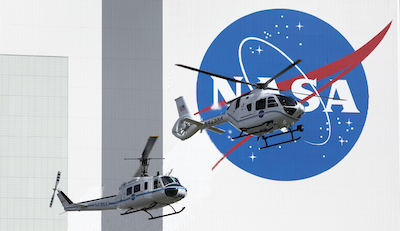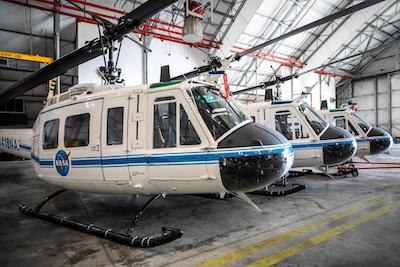|
Mar
01
2021
|
|
Posted 4 years 301 days ago ago by Admin
|
|

I find it curious that the first flight on the surface of another planet will be attempted via a helicopter.
As I write this article (February 2021), we are only days away from NASA’s Perseverance Mars rover landing on the surface of Mars. This new Mars rover is on the cusp of plunging into the Martian atmosphere to land on the Red Planet and is equipped with panoramic cameras, subsurface radar, laser micro imager, x-ray spectrometers, and a weather station. But there’s one more innovative piece of equipment that will be dropped from the belly of the Mars rover onto the planet’s surface: Ingenuity, the Mars helicopter!
Ingenuity is what’s known as a technology demonstrator and it’s sole purpose is very narrow in scope. Ingenuity’s goal is an engineering one: to demonstrate rotorcraft flight in the extremely thin Martian atmosphere, which has just around 1% of the density of our atmosphere on Earth, and can experience temperatures that can be as cold as -130 degrees fahrenheit.
Currently, Ingenuity is orbiting Mars safe in the undercarriage of the Perseverance Mars rover with its health checks complete. If it survives atmospheric entry and landing on Mars, which is scheduled for 18 February 2021, Ingenuity will attempt its first flight a month later.
112 Million Miles Away
Meanwhile, 112 million miles away from Mars, back here on Earth at the Kennedy Space Center (KSC), are real helicopters performing real missions supporting many of NASA’s earthly and space bound initiatives. And so it goes, the Airbus H135 launches itself on a first-time endeavor to support space exploration.

From 1949 to 1961 the U.S. military had been performing missile launch testing from Cape Canaveral. Then in 1961, President John F. Kennedy launched the national goal of a lunar landing before 1970. This effort would facilitate the need for larger facilities that could accommodate much larger rockets, like that of the massive Saturn V rocket weighing in at 6,540,000 pounds. So in 1962, NASA began acquiring nearby land on adjacent Merritt Island from the State of Florida to develop what would become the KSC.
Today the KSC covers 144,000 acres of land and is home to over 700 facilities, launch pads, and buildings: the Launch Control Center, astronaut crew quarters, a visitors center, and the iconic Vehicle Assembly Building (VAB). Its 130,000,000 cubic feet make it the seventh largest building on earth by volume.

Most of the Cape’s 219 square miles are a restricted area and only 9% of the land is developed. So, the site also serves as an important wildlife sanctuary and home to a variety of species like bald eagles, American alligators, wild boars, eastern diamondback rattlesnakes, the endangered Florida panther and Florida manatees.
Since 1980, helicopters have been used as part of KSC and Cape operations when NASA purchased a fleet of military surplus Bell UH-1 Hueys with a primary role of supporting the developing Space Shuttle program. The Hueys have flown many mission profiles and have served NASA aviation operations well for 40 years. However, as technology advances are impacting space exploration, so too are they ushering in a new era of modern helicopters.
GOOD TO KNOW INFO:
As early as the late ‘60s, astronauts received helicopter training in the Bell 47 in order to build hand-eye coordination in preparation for operations like controlling the lunar landing module and docking spacecraft.
Enter the Airbus H135
At Heli-Expo in January of 2020, Airbus Helicopters reached a new milestone when NASA placed an order for three H135 helicopters as part of a fleet modernization program. This event marked the first-ever partnership between the U.S. space program and the OEM. For decades, NASA had relied on a fleet of three Bell Huey 2 helicopters to perform its support missions.

In the fall of 2020, two of the three H135 helicopters were delivered to the space agency with the third helicopter scheduled for delivery this spring.
“NASA chose the H135 because Airbus was able to meet all the NASA mission requirements which include personnel movements, airborne law enforcement roles, aerial firefighting, weapons training, and overwater operations,” said Dave Ramsey, NASA’s chief of flight operations at the Kennedy Space Center in a statement.
Given the 30-year-long history of NASA aviation ops with the Bell Huey 2, it seems the new aircraft will have big shoes to fill, at least from an emotional standpoint. However, pound for pound, the H135s will enhance operational safety and bring new capabilities to the mission.
The H135 T3 helicopters are IFR-certified, twin-engine aircraft with a four-axis autopilot, a state of the art single-pilot IFR Helionix cockpit, and include a variety of special missions equipment. The H135s will be used in a true multi-mission role.
The H135s will be tasked with many security missions. Also, Florida is known as the lightning-strike capital of the U.S., as such, brush fires are a real risk to the facilities and surrounding landscape, so the aircraft must have firefighting capability as well. The aircraft are also outfitted with a light air ambulance interior in the event of an emergency, during a launch or otherwise, and an injured or sick person needs to be transported to a hospital. Of course, many of these operations can occur both at night and/or offshore so special capabilities like FLIR (forward looking infrared) and night vision goggles further enhance safety.
Since the KSC borders the Merritt Island National Wildlife Refuge, the helicopters also support bio-research efforts. For example, flight operations may be tasked to fly biologists to count fledgling eagles. The upgraded FLIR cameras on the H135s allow teams to zoom in on eagle nests, eliminating the need to get close to the nests in order to perform these counts.

Partnerships
As with any high-profile aircraft deal, there can be several partners collaborating and working towards the common goal of building the aircraft, getting them into service and supporting the customer. In this NASA case, the transition from legacy airframes that have been operated by NASA for 30 years to new modern day helicopters was no exception.
At the center of the partnership was Davenport Aviation. NASA acquired the aircraft through Davenport, an SBA-certified woman-owned small business specializing in the supply of aerospace equipment to federal, state, and local government agencies. Giving consideration to the right aircraft for the job, Davenport indicated that the H135 was selected because it has the technological and performance capabilities necessary to perform NASA’s demanding multi-role mission set. Its reliable, twin-engine design, and fuel efficiency allow longer time on station and critical margin for overwater operations.
“Our team at Davenport Aviation feels extraordinarily proud to have supplied NASA’s state-of-the art rotorcraft through our GSA contract vehicle,” said Joao Simoes, president and CEO of Davenport. “It’s inspiring to have contributed to the advancement of the United States space exploration programs.”
The H135s had a couple of stops in order to finish them and bring them up to operational readiness. First, the aircraft were assembled and delivered to the customer from the OEM’s production and completion facility in Columbus, Mississippi, the same location where the U.S. Army’s UH-72 Lakotas are built. Since it opened in 2003, more than 1,300 aircraft have departed the Mississippi facility which has more than 200 employees, with 40 percent being U.S. military veterans.
During the process, Airbus called on its trusted completion partners at Metro Aviation out of Shreveport, Louisiana. Metro Aviation routinely works with Airbus to develop complex interior completions and they were asked to develop a multi-mission package to meet NASA’s requirements, which included a light aeromedical interior as well as the FLIR camera and downlink system. "Our completion center is accustomed to working on unique and outside-of-the-box configurations, but to have the opportunity to collaborate with the National Aeronautics and Space Administration is something most people could only dream of," said Metro Aircraft Configuration Coordinator Amy McMullen. "We worked closely with Airbus, Davenport, and NASA's chief of flight operations to customize these three H135 aircraft to their unique mission, and I can't think of a more experienced completion center to work with the nation's space program."
An Important Mission
As for Airbus itself, this arrangement is not only an important one to ensure the success of the customer, but unique in its structure as well. I know that all customers and their success is important, but c'mon, this is NASA! Space explorations, rockets, astronauts, and helicopters. I cannot think of many things cooler than that and Romain Trapp, president of Airbus Helicopters Inc. and head of the North American region seems to agree:
“Airbus has a long history of partnership with NASA, and the new helicopters are another step in this journey. It’s a dream for many of the Airbus employees to work on helicopters that will, in their own way, help support the agency’s mission of putting the first woman and then next man on the moon in the next few years. I myself have dreamed of space exploration since I was a kid, and being able to see the NASA logo being painted onto one of our helicopters – it’s amazing,” said Romain Trapp. “It’s been an immense honor to work with everyone at NASA, and their professionalism and commitment to the same values of quality and safety as Airbus is what allows this relationship to continue to advance.”
The deal doesn’t stop at purchase though, it goes much further than that to include a $15 million HCare Infinite “full-availability” support solution. HCare Infinite is the Airbus highest level of customer support and requires the company to guarantee the customer’s full fleet operational availability, including maintenance, technical support, and the supply of spare parts, tools, and consumables. The contract initially covers the first 2 years with an option to extend up to 10 years. “Our customers’ success lies in their ability to ensure aircraft are ready to take off the second they need them, and our HCare support solutions provide the guarantee that we have taken care of everything to ensure their full fleet availability,” said Anthony Baker, vice president of Customer Support and Services at Airbus Helicopters Inc. “Our entire team is extremely proud to support the future of space exploration by providing both new helicopters and full support services to NASA.” Additionally, Airbus will be responsible for the helicopter flight operations by stationing two pilots, two mechanics and one program manager at NASA’s Kennedy Space Center.
“With this new HCare contract, NASA is relying on Airbus’s manufacturer expertise for the comprehensive management of all support and service needs. The OEM experience and knowledge will provide support as NASA transitions from an aging aircraft fleet into the advanced H135 helicopter,” said David Ramsey, chief of flight operations at NASA Kennedy Space Center in a statement.
Given the current space exploration renaissance, by all accounts, the Airbus Helicopters - NASA agreement is as high-profile and high-flying as it gets. One thing for certain is that all parties involved should be over the moon about the partnership.